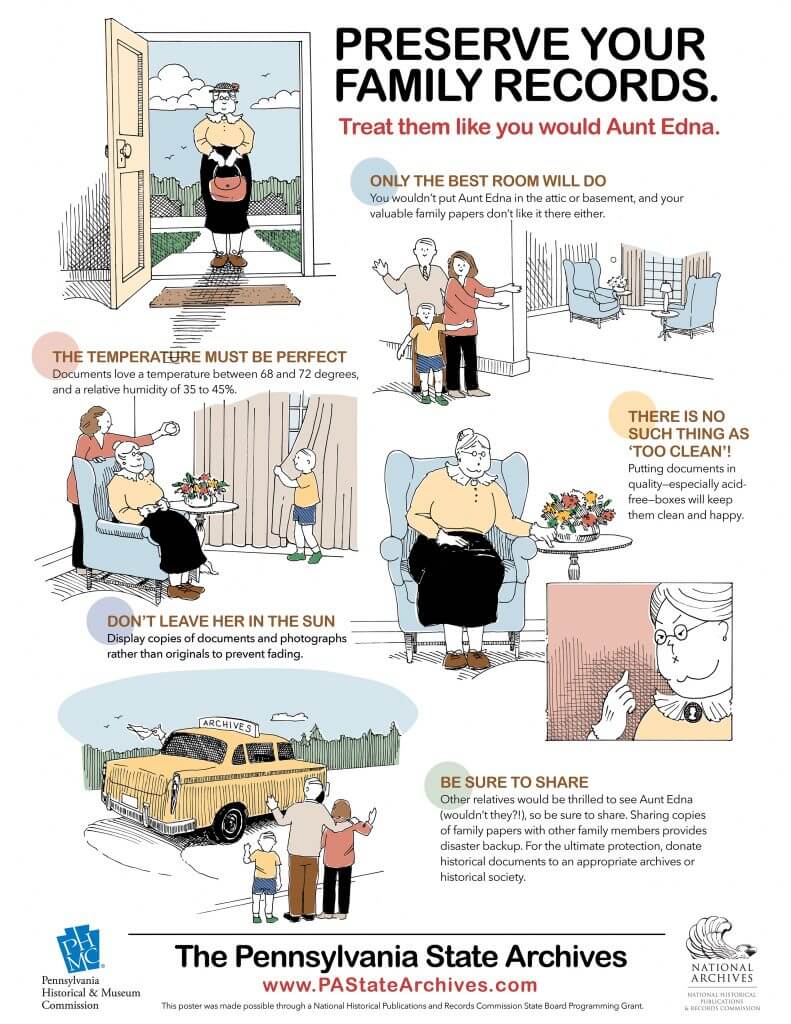The upcoming month of October happens to be Family History Month. For all you genealogy buffs and future historians out there, here are a few tips on how to best care for the family heirlooms.
For books, papers and photographs the number one rule is keep them in a clean and dry environment, avoiding direct sunlight. This does not mean a shoe box in your basement, next to the Pittsburgh potty. Get any sentimental and irreplaceable objects out of those damp spaces. Preferably, a regularly temperature controlled room or closet. Heating and cooling extremes are bad for paper. Think of paper as the once living organism it is. Like our own skin, it cracks and becomes rigid with dry cold air (think of wind chapped lips in February). In the heat and humidity, it is no better off and can even sprout mold (like getting caught in a summer rain storm). Books stored on top or over radiators or fireplace mantels may look decorative, but those extreme heat sources are brutal for that poor paper not to mention a fire hazard. Do not place your first editions and scrapbooks on radiators, or your south-facing windowsill!


If environment is rule number one, next on the list is the type of container they are stored in. (spoiler alert, garbage bags are NOT preservation grade storage) Regular cardboard boxes or envelopes are not ideal either, and can cause further damage to materials over time. The good news is there are plenty of options for preservation grade boxes and folders to store a number of items. When searching for these containers, look for descriptions that use the term “archival quality” for best results. Trusted suppliers are listed here, here, here and here.

The third must is to make copies and share your items if possible. Newspaper clippings can be copied onto buffered paper and photos on archival photo paper. If a photograph is particularly fragile, you may consider handling and displaying the copy while keeping the original in an archival-quality photo sleeve or album. Digital records are very popular, and great for instant accessibility. Just remember, digital records need to be updated, and if you can, keep the original in a cool dry safe place! Please don’t think the photos on your phone will be there for you five, ten or fifteen years from now without you doing some leg work. Transfer important files onto an external hard drive (or two) and rewritable CDs to share with friends and family. To be safe, open a couple of the files to make sure everything transferred properly. Take notes on who people are, dates and locations to include in your research.

When in doubt, contact a preservation specialist or conservator. Here is a list of some trusted local sources.
Local Conservators:
Wendy Bennett – Specializes in Fine art and paper.
wen.bennett@gmail.com
412-608-7600
Jim Burke – Specializes in photographs.
c/o Pittsburgh Filmmakers
412-681-5449
Csilla Crisanti – Specializes in book, paper and leather.
csillacrisanti@gmail.com
Amy Williams -Specializes in book and paper
amy.e.baker@gmail.com
Trusted Preservation Sources
Retail
Gaylord Archival – http://www.gaylord.com/c/Preservation
Hollinger Metal Edge – https://www.hollingermetaledge.com/
Talas – http://www.talasonline.com/
University Products – https://www.universityproducts.com/
Further information and websites
Northeast Document Conservation Center – https://www.nedcc.org/
Conservation Center for Art and Historic Artifacts – http://www.ccaha.org/
Library of Congress – http://www.loc.gov/preservation/
National Archives and Records Administration – https://www.archives.gov/
Alliance for Response – http://www.heritageemergency.org/initiatives/alliance-for-response/afr-home/
Alliance for Response PGH – https://sites.google.com/site/afrpittsburgh/
Heinz History Conservation Center – www.heinzhistorycenter.org/museum-conservation-center
Want to know more? Join the Conservation Preservation and Access Department October 19 at 5 p.m. in the CLP – Main Preservation Lab for more tips!
-Emma M.
